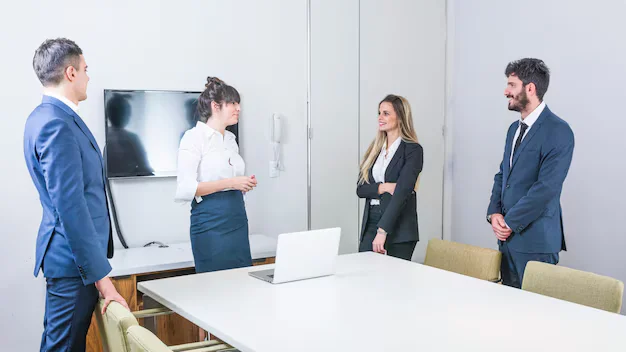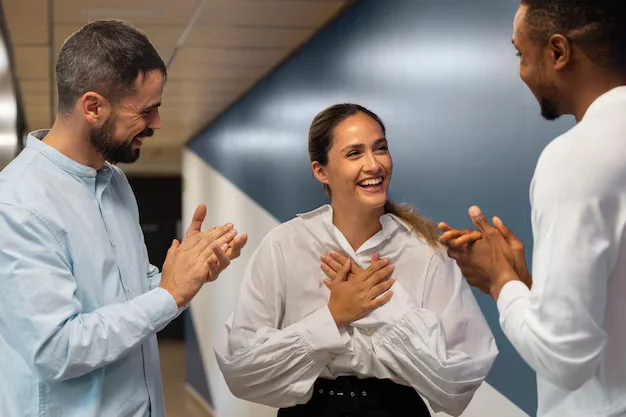Body language: How to control your body in meetings and at work
Unlike our highly developed verbal languages, body language is something we've always been fluent in. It's how we speak in the silence, and how we communicate our feelings and intentions to others, long before someone's words are ever uttered, making use of nonverbal communication cues.
But what about in the workplace? What's the right way to use our body language tips when pitching an idea in a virtual meeting or asking for a bigger paystub, especially when you're actively interpreting body language? And how can we control and read our own nonverbal cues to make sure we're coming across in the best possible way, ensuring we use the right hand gestures and maintain good posture?
In this article, we'll explore the information about body language, how to control your body in meetings and at work, world of body language in work meetings, and look at some tips on how to use it effectively.
Body language: the basics

Before diving into virtual meeting-specific body language, it’s important to understand the basics of nonverbal communication in general. There are three main aspects to body language:
1. Positioning
Your positioning is everything to do with your good posture, how you hold yourself, and how you interpret body language. Posture can be characterized into four types: open, closed, guarded, and relaxed.
Generally speaking, you want to aim for an open posture – leaning forwards slightly, keeping your arms away from your chest or front, and keeping your chin up to maintain eye contact and show you’re fully engaged. This shows that you’re interested and engaged in the conversation.
Closed posture, on the other hand, suggests that you’re closed off or uncomfortable, while guarded posture implies that you’re feeling threatened or under less pressure to convey information. Relaxed posture indicates that you’re feeling comfortable and confident.
2. Gestures
Illustrators, emblems, and adaptors are the three types of gestures. Illustrators are what you use to explain or emphasize something – for example, making a point with your hand gestures. Emblems are culturally specific hand movements that have a clear meaning, such as the American “thumbs up” sign, which may differ in arab countries. Adaptors are unconscious reactions to stress, such as nail biting or fiddling with your hair, indicating certain emotional states.
It’s important to be aware of the nonverbal signals you use and to make sure they’re appropriate for the situation, especially during a virtual call. For example, illustrators can come across as pushy or aggressive if used at the wrong time, while adaptors like nail biting can make you look nervous or unprepared, reducing your ability to pay close attention.
3. Facial expressions
Your facial expressions are one of the most important aspects of your own body language, as they’re the easiest to read and the most visible, especially in virtual meetings where the computer screen is your main medium. Some common facial expressions that can give away your emotions include smiling, frowning, furrowing your brow, and rolling your eyes, which are all part of your own body language that helps others in paying attention to your nonverbal communication.
You want to aim to keep your facial expressions positive and open, as negative expressions can be off-putting or make you seem unprofessional, especially when actively listening to a person's body language during virtual meetings. Be aware of your eye contact, too – maintaining strong eye contact shows that you’re interested and engaged, while avoiding eye contact can make you seem untrustworthy or evasive, particularly when talking and paying attention to other people's body language on a computer screen.
How to use your body language in meetings

Unlike asking your clients to generate a 1099 form over the phone, in-person meetings rely on both your verbal and nonverbal communication. Let’s take a look at some tips for using body language in virtual meetings, focusing on how body language helps in paying attention and interpreting other people's body language.
Body language interpretations
The work meeting generally serves one of a few purposes: to make a decision, to communicate a change or idea, or to update the group on progress. In all of these cases, effective communication is key. And body language can play a big role in how your message is interpreted.
In order to use your body language effectively in a meeting, you first need to understand how people's body language is interpreted by others, especially during virtual meetings. Generally, people read three main things into body language: dominance, submission, and attraction.
Dominance is communicated when a person takes up space, stands tall with their chest open, and makes eye contact, reflecting confident nonverbal communication that can be crucial in both in-person and virtual meetings. This shows that the person is in control and confident, a key aspect of using body language to maintain authority and ensure effective nonverbal communication.
Submission, on the other hand, is communicated when a person takes up less space, stands with their shoulders hunched, and avoids eye contact; it shows that the person is uncertain or lacks confidence, which can be observed in both in-person and virtual meetings through their own body language.
Attraction is communicated through body language cues such as open postures (spreading out), smiling, and making eye contact, which are important elements in understanding body language during virtual meetings. This generally indicates that the person is interested in or attracted to the person they are communicating with.
Even the best negotiation tactics won’t work without the right body language, so it’s important to understand how to use body language effectively in a professional setting, especially during virtual meetings.
How to use gestures in meetings

First up, let's explore gestures. When used effectively, gestures can help to communicate your message more clearly, playing a significant role in virtual meetings where nonverbal communication is crucial. However, when used ineffectively, gestures can actually hinder communication, making it difficult for others to interpret your body language correctly.
We discussed that there are three types of gestures: illustrators, emblems, and adaptors, all of which are integral parts of nonverbal communication in virtual meetings. In a meeting, the illustrators you should use are the ones that help to make your point, enhancing your nonverbal communication and making your body language more effective. For example, you might use your hands to gesture to a presentation or your audience, ensuring that your body language supports your verbal communication.
However, you'll want to avoid pointing at individuals or making your gestures overly domineering, as it can negatively impact how your body language is perceived. When someone wants to feel threatening, they make themselves bigger; that's not the message you want to send when trying to communicate well and build relationships in a meeting, whether it's in person or a virtual meeting.
Next, your adaptors should be used to calm or focus yourself – but be aware of appearing fidgety or restless, as it can detract from your nonverbal communication and make you seem less confident. If you're constantly having to adjust your clothing, hair, or jewelry, it can be a distraction to others and make you appear unprofessional, which is especially problematic in virtual meetings where paying attention is crucial.
Instead, try to find a comfortable position, sit upright, and maintain an open posture to ensure your body language supports your message. If you need to let out a nervous tic, try to do it subtly and unobtrusively (such as squeezing the side of your chair or rubbing your hands together subtly), as this will help maintain a professional appearance and effective body language.
Finally, use emblems to bring everyone onto the same page, ensuring that your body language is clear and consistent with your verbal communication. Has your company grown accustomed to certain signals, such as a hand gesture that is specific to your team, which can be an important part of your nonverbal communication in virtual meetings? Use it in the meeting to make sure that everyone is on the same page, ensuring that your body language is effective and supportive of your message. Even universal signs like a thumbs up or a head nod can help to communicate positively, enhancing your nonverbal communication and making your body language more effective.
How to position yourself in meetings

When you are in a meeting, the best way to position yourself is to have an open posture. A closed and defensive posture – one in which you have arms crossed, or you are leaning away from the group – will make you seem uninterested and untrustworthy. An open posture, on the other hand, signals that you are engaged and interested in the conversation.
Remember that posture really conveys how confident you are and how comfortable you feel in the situation. So, try to keep your spine straight and your shoulders back, even if you don’t feel confident. This will help you to project an image of strength and confidence, and you might even convince yourself that you are feeling confident!
How to use facial expressions in meetings
Finally, keep your facial expressions in check during meetings – but not so much that it seems fake. Rolling your eyes or making exaggerated facial expressions will make you seem uninterested and untrustworthy while smiling constantly and nodding along will make you seem insincere.
Instead, try to mirror the facial expressions of the person who is speaking. This will show that you are engaged in the conversation and that you are taking the speaker seriously. It will also help to build rapport with the other participants.
You can learn meeting tips from the biggest and brightest businesspeople, but without understanding body language, you won’t get too far!
Conclusion
Hopefully, these simple tips will help you to control your body language in meetings and at work. Remember – running a meeting is very different from doing admin or generating W-2 forms. You need to be aware of how your body language is being interpreted by those around you and act accordingly.
The main thing is to keep your posture open, your face engaged, and your gestures minimal. Use your voice to project authority, and make sure that you maintain good eye contact. By following these tips, you will be able to control your body language and project a confident image in all of your work meetings.

